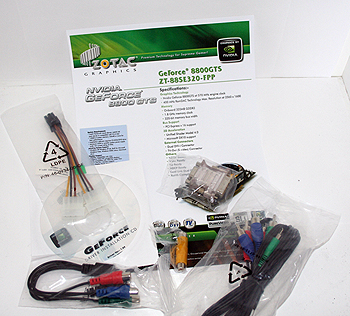NVIDIA SLI requires the use of two boards, so Zotac were kind enough to supply a pair of boards for our testing, although we haven't taken advantage of it just yet. We're not terribly sure the box art will be effective in selling the product in any great numbers, but look past it and you'll spot the specifications. The memory count, its RoHS compliance, the bus it rides, its SLI support, its DirectX revision support and the SKU name itself (among the myriad details) are all there for you to take notice of.
We nudge Zotac towards a classier approaching to the art used for the marketing push of their boards, if possible, although that might just be us being a bunch of old farts. We'd also advise Zotac to make clear the fact the hardware is overclocked out-of-the-box, to differentiate it from the reference clocked version. We can't spot the board's clocks anywhere on the box as it stands, and it's a selling point.
Inside you get a driver CD (our sample came with drivers for Windows 2000, XP and Vista, with x64 and 100-series flavours where appropriate), component output cable (and extension to that, sweet) for TV use (HD is supported), DVI (both ports are dual-link, by the way) to VGA adaptor, power splitter cable should your PSU not have one, and a composite adaptor to round things off.
There's not much else to say, really. Zotac make sure you can connect up to the board's output options without having to buy extra cabling, and you get drivers for all the target operating systems out of the box, letting you attempt to setup display options without grabbing a new driver from the net. Speaking of which, Zotac don't actually ship or make available drivers of their own. Instead they point you straight to http://www.nvidia.com/content/drivers/drivers.asp
We check out stock-clocked performance next, versus GTS 640MiB and GTX, before we look at what the out-of-the-box clocks buy you versus that stock performance.


